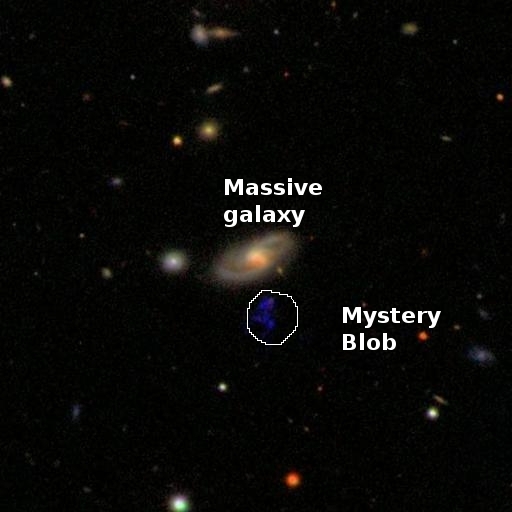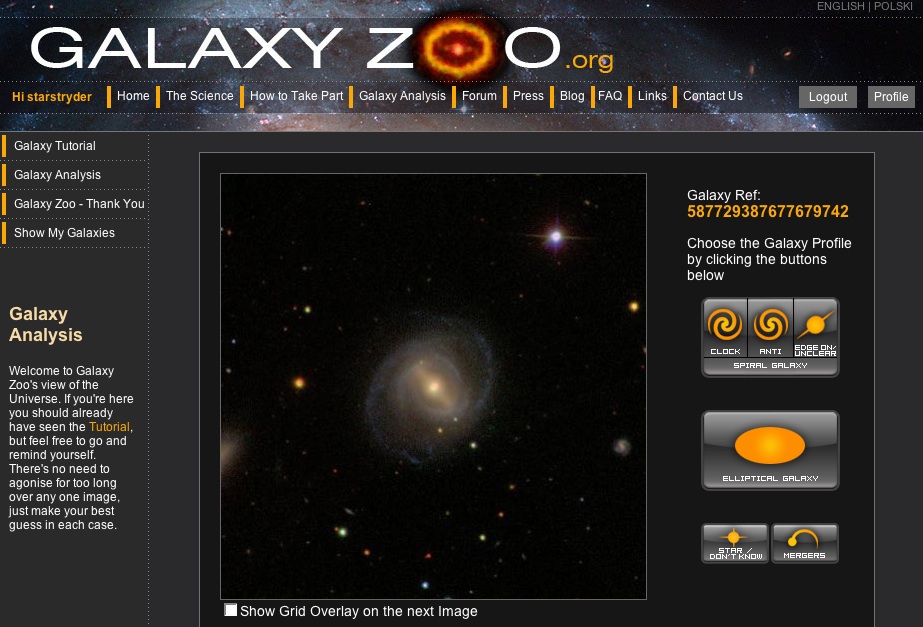In the near future, Galaxy Zoo will get a facelift. The project – which has already classified a large portion of the Sloan Digital Sky Survey – will be moving to its second phase, and members will be helping the science community get better information on the formation and distribution of galaxies.
In the first phase, the science team wanted to make the task as simple as possible: is the galaxy you see an elliptical or spiral galaxy, and if it’s spiral, which way is it turning (clockwise or counter-clockwise)? As we reported the first results published using the Galaxy Zoo data showed that people have a bias for clicking on counter-clockwise images.
Galaxy Zoo 2.0 will probe more deeply some of the best classified images of the first stage. “The experience will be a bit different. Users will be asked a series of more detailed questions, and based on their answers they will be lead to answer different questions…One of the things we will incorporate is how to get people to answer the questions in a way that is interesting for them” said Chris Lintott a member of the Galaxy Zoo team and a post-doctoral researcher in the Department of Physics at the University of Oxford.
The more detailed questions will focus on a few hundred thousand of the million galaxies used in the first phase. The researchers want users to answer questions such as where on the Hubble Diagram a galaxy is, how many spiral arms it has or how close together are the spiral arms are.
Galaxy Zoo 2.0 will also improve upon the ability for people to point out unusual galaxies or objects, including them even more in the science behind the project. The “poster child” of interesting objects from the site is Hanny’s Voorwerp (pictured).
 It popped up as an unusual object in the forums, and the science team has since gotten time on the Swift and SARA telescopes for observation. The object turned out to be a ‘light echo’ from a long-dead quasar. More information (and pictures) can be found here and here.
It popped up as an unusual object in the forums, and the science team has since gotten time on the Swift and SARA telescopes for observation. The object turned out to be a ‘light echo’ from a long-dead quasar. More information (and pictures) can be found here and here.
From April 25th-29th, part of the science team will be observing a few of the over 500 overlapping galaxies pointed out by Galaxy Zoo members, using the 3.5-meter WIYN telescope at Kitt Peak, Arizona. Overlapping galaxies provide astronomers with a chance to study the interstellar dust in each galaxy, which aids in understanding how galaxies evolve.
“The new GZ will make it easier for people to point out what they think is interesting…One thing that the users are going to probably have the most fun with is a button that basically says, ‘Hey, somebody should look at this,'” Lintott said.
After they had asked users in the first few weeks of the project to email them with interesting finds – like ring galaxies, which they had thought were rare, but turned out to be rather abundant – the team received a barrage of emails. The new function for picking out interesting finds should streamline the process, making a shorter turnaround for observations of objects such as the Voorwerp.
“I like to compare Galaxy Zoo one to eating a bag of crisps. You start by eating one and then soon enough you’ve finished the whole bag. Galaxy Zoo two is like eating Michelin starred food: you want to spend time considering it and thinking about it and wondering about what is going on,” Lintott said.
The site will be connected to the Sloan Digital Sky Survey – a robotic survey of 1/4 of the Northern sky, where the images on the site originate – so people can go there and check out the objects in more detailif they would like.
Harnessing the power of 125,000 registered users and counting, the site has become a powerful (and popular!) tool for classification. There are currently over 20 projects underway using the Galaxy Zoo data. Galaxy Zoo 3.0 is already in the planning stages, and will likely include a look at more sky surveys, such as the upcoming Pan-STARRS.
“People looking at the data should become something that happens to astronomy surveys, more as a matter of course. Some human beings should look at it, or we’ll never find things like the Voorwerp and overlapping galaxies. Things like Galaxy Zoo let people play a part in the science,” remarked Lintott.
Source: Interview with Chris Lintott, Galaxy Zoo Blog

